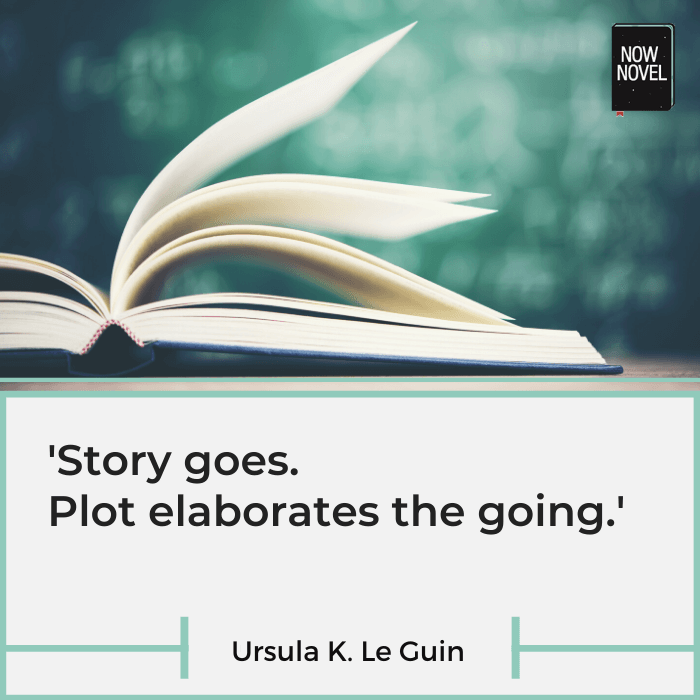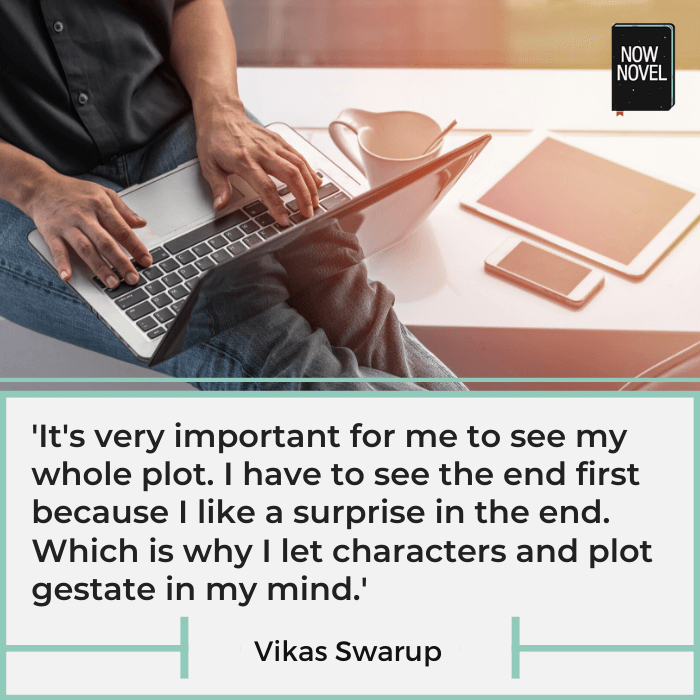What makes a plot keep you turning pages? Plot has many moving parts. Incidents and elaborations, causes and effects, doubling back and forecasting approaching events. Learn more about the relation between 'plot' and 'story' and ways to make your plot more captivating:
1. Elaborate your story's going
A definition of plot reminds us that plot is about connection. The Oxford English Dictionary defines plot as:
'The main events of a play, novel, film, or similar work, devised and presented by the writer as an interrelated sequence.
There are many ways to create 'interrelated sequences' in stories. E.M. Forster said that plot is 'The queen died and then the king died of grief', whereas 'The queen died and then the king died' is just story.
Here, causation is what Forster suggests is the difference between 'plot' and 'story'. The king's dying of grief is explained by the context preceding events (the queens' death) and the grief they cause.
Yet plot doesn't necessarily give us every connection. Sometimes we have to form our own. Ursula K. Le Guin gives an interesting alternate view in 'The Narrative Gift as a Moral Conundrum':
Plot introduces connection or causality [according to Forster], therefore shape and form. I don't believe this. Children often tell "this happened and then this happened," and so do people naively recounting their dream or a movie, but in literature, story in Forster's sense doesn't exist.
Ursula K. Le Guin, 'The Narrative Gift as a Moral Conundrum' in No Time to Spare: Thinking about what matters (2017), p. 75
Even the choice of simply grouping events together - like a child might - is giving them a kind of connection, according to Le Guin. Their juxtaposition forms a whole. Whence we have 'slice of life' stories that don't have much plot to speak of, perhaps, but may brim with character all the same.
Le Guin gives a different comparative statement about 'plot vs story':
Story goes. Plot elaborates the going.
Le Guin, p. 75
And it's true. What makes a story good? It elaborates the going. The queen dies, the king dies of grief, and then what?

2. Pause for suspense
In her essay, Le Guin gives examples of many ways that plot can elaborate the way a story unfolds:
Plot hesitates, pauses, doubles back (Proust), forecasts, leaps, doubling or tripling simultaneous trajectories (Dickens), diagrams a geometry onto the story line (Hardy), makes the story Ariadne's string leading through a labyrinth (mysteries), turns the story into a cobweb, a waltz, a vast symphonic structure in time ...
Le Guin, p. 75.
Let's take the first way a plot can elaborate a story's going:
Literature is full of moments in stories where a pause in the flow of anticipated story events - the deferral of an expected development - creates narrative suspense.
One of the best examples of this is Samuel Beckett's famous play, Waiting for Godot.
In the play, two tramps, Vladimir and Estragon, wait for the arrival of a mysterious 'Godot' under a tree. Other characters keep arriving, but not 'Godot', and the tramps bicker, lament the endless waiting, and so on.
The tramps' constant waiting maintains viewers' suspense regarding Godot's anticipated arrival (which never comes).
The pause in the flow of anticipated story events itself becomes the action, as well as a source of absurd, wry humour and pathos.
Beckett achieves captivating suspense with very little action. The drawn-out pause under the tree is milked for conflict, frustration, despair - all the emotions that make stories riveting.
[Develop a fuller plot and brainstorm rising and falling arcs in the 'Core Plot' section of our story outlining dashboard.]
3. Double back
The second type of way plot elaborates story that Le Guin mentions is another good way to create interest.
Many stories use memory, backstory - origins - to elaborate their going.
How did Anakin become Character X [no spoilers] in Star Wars, for example? Movies 4 through 6 of the franchise double back to events that occured chronologically before the events of movies 1 to 3 to elaborate.
There are all kinds of ways to double back for a more interesting plot. You could:
- Show earlier events that make the reader question the truth of what the narrator has told them in present-time narration
- Explore the origins of a character's later years to give their arc humanity and greater depth (both J.K. Rowling in Harry Potter and the Star Wars franchise do this for their villains)
4. Forecast dramatic incidents
What makes a plot nail-biting? Anticipation is a major element. In detective fiction, we anticipate new crimes or the culprit's capture. In fantasy, it might be the outcome of a quest, or a villain's comeuppance.
'Forecasting' is another way plot elaborates story.
Introduce a task, an ominous name, or an objective a while before an occasion arrives to create narrative suspense.
When you forecast events in your story, make them intriguing by:
- Giving an emotional component (e.g. a survivor has to pick out their assailant from a line-up)
- Suggesting stakes (for example, if the survivor gets their choice wrong, their assailant could walk)
- Raising unknowns (how the survivor will react in this situation, or the assailant)
5. Give simultaneous trajectories
What does Ursula K. Le Guin mean by 'doubling or tripling simultaneous trajectories'?
If, for example, there were 3 children in line to the throne in the story scenario 'The queen died and then the king died of grief', and all 3 set about trying to seize said throne, that would be an example of this.
Another example would be the move to both destroy the One Ring (the heroes' journey) and reclaim it (the villains' own) in Tolkien's The Lord of the Ring cycle.
Give characters simultaneous goals that compete or conflict for tension. For example, in a prestigious international music competition, one character might practice all hours while another tries to manipulate and sabotage their rivals. We see both at work, and wonder who will come out on top.

6. Play with plot shape and structure
Le Guin describes how Thomas Hardy makes a plot develop by 'diagramming a geometry' onto a story line.
This sounds confusing, but think about plot devices such as the classic 'love triangle'. A romantic arc between 3 characters creates interesting structural possibilities.
Michael Cunningham, for example, in his novel A Home at the End of the World (1990), tells a chapter at a time from each of three characters in a love triangle's perspective. We get a three-fold, simultaneous elaboration of the characters' shared history. There's pathos in how their desires and longings differ.
You could treat how you elaborate your story's going as a pure game of shape and structure.
The example we often return to is David Mitchell's Cloud Atlas. Each section of the story is interrupted by the next on a cliffhanger, leading up to the middle section after which the arcs resolve in reverse order (so that the story ends with the same location and POV character as the first chapter, and answers remaining questions).
The above are just 6 ways to add interesting elements to a plot. Yet there are many more ways to experiment with how you elaborate your story. As Le Guin says:
There are supposed to be only so many plots (three, five, ten) in all fiction. I don't believe that either. Plot is manifold, inexhaustibly ingenious, endless in connections and causalities and complications.
Le Guin, p. 75
Need help developing your plot and improving your story? Get thorough feedback from an editor or work with a writing coach to develop your story.










Good stuff. In every way, the best stories always seem so simple, because all the hard work is done in making.
2 Cents 'N' - Almost 6 years ago
That's true, 2Cents. The same goes for a lean prose style. Thank you for sharing your thoughts :)
Jordan At Now Novel - Almost 6 years ago